| Botanical Name |
|
| Family |
Malvaceae - The hibiscus and cotton family. |
| Pronunciation |
grew-EE-uh ok-sih-DEN-tal-iss |
| Common Name(s) |
Afrikaans: Kruisbessie; Assegaaibos
Sesotho sa Leboa: Mogwane
|
| Plant Group |
- Shrub A woody plant of relatively low height, having several stems arising from the base and lacking a single trunk; a bush.
|
| Plant Size |
- Medium to Large
| Tree | 15m to 20m |
| Shrub | 2m to 3m |
| Perennial/ground cover | 60cm to 75cm |
| Bulb | 60cm to 1m |
| Succulent | 60cm to 1m |
|
| Position |
- Canopy Shade Canopy shade is found below closely grown trees where some light filters through. Ideal for the protection of herbaceous plants.
- Deep / Full Shade Shade below spreading evergreen trees where sun's rays are unable to penetrate the canopy at any time. For light sensitive plants
- Dry Shade Shady areas where soil has poor water retention or are dependent on rain for their moisture needs.
- Light or Dappled Shade Found below trees with sparse, open foliage. Ideal for the protection of herbaceous plants.
- Partial Shade The area is in shade for part of the day and in full sun for part of the day.
- Sun The area is in full sun for all or most of the day, all year round.
|
| General Information |
- Attractive fruits, berries or seeds Brightly coloured fruits or berries increase and extend the visual impact of the plant and are especially attractive to birds and other small wildlife.
- Drought Tolerance: High The plant is well adapted to arid conditions; it can survive long periods of drought and high temperatures without extra water.
- Evergreen Plants that have leaves all year round.
- Frost: Half-hardy The plant is able to survive low temperatures and some frost but requires protection against severe frost.
- Prune hard after flowering Fast growing shrubs that grow lanky within a season. Cut off branches and stems of these plants to a third of their original length. This will increase the yield of flowers, improve the plants shape and enhance the structural strength of main branches.
- Roots Non-invasive Safe to plant near pools, paving, walls or buildings.
- Salt spray tolerant A plant with specific adaptations enabling it to grow in a saline environment.
- Sand tolerant Plants adapted to survive in nutrient poor, very sandy soils.
- Water Wise Plant species originating from low rainfall regions that require less water to survive and thrive than other plant species.
- Wind Tolerant Plants able to withstand the effect of strong winds.
|
| Specific Information |
Shiny, deep green leaves, purple flowers, and distinctive, almost square, edible fruits make Grewia occidentalis a useful shrub for the garden. In its natural habitat, Grewia can be very untidy, straggly and lacking in shape as it scrambles through the surrounding bush, which is perhaps why it is seldom utilised as a garden specimen. However, this plant takes readily to pruning and clipping and makes a most useful background shrub. If kept cut back it develops a dense branch system ideal for shy birds such as robins, the fruits attract fruit eating birds and the flowers are especially attractive to butterflies.
|
| Ad Break |
|
| Flowers |
| Description |
star-shaped with narrow, pointed petals and protruding yellow stamens
|
| Season |
- Summer Plants will seldom bloom for the entire season as given in the list, but should flower during a period within these parameters.
|
| Colour |
|
| Growth Rate |
- Fast Specifying growth rate can be very misleading as there is considerable variation of growth rate depending on type and species of plant, available water, supplementary feeding, mulching and general care, as well as the plants suitability and adaptability to the garden environment.
|
| Plant Uses |
- Attracts bees, butterflies or other insects This plant attracts insects which can be food for birds or other creatures in your garden.
- Attracts Birds This plant will attract birds.
- Border A strip of ground, at the edge of a driveway or path in which ornamental plants or shrubs are planted.
- Boundary A plant useful for planting around the edges of the property to form a green or colourful backdrop, an impenetrable hedge, to hide walls or create privacy.
- Filler Either a fast growing tree or shrub used temporarily to fill in an area while the permanent plants grow to a desired size, or a plant used to fill gaps in borders or beds.
- Hedge Suitable trees or shrubs planted relatively close together so that the branches intertwine to create a barrier. This can be formal – the plants are regularly trimmed to produce a neat shape, or informal – the plants are left to themselves to create a natural hedgerow.
- Pioneer for new gardens A very fast growing plant, able to withstand hardship, that can be used to populate land that has recently been cleared of natural vegetation. These plants pave the way for slower-growing species by adding nutrients to the soil and creating leaf litter.
- Provides light / dappled shade A tree with an open to sparse canopy, through which varying degrees of sunlight can penetrate.
- Suitable for coastal gardens Plants adapted to dry, sandy soil, forceful wind, limited rainfall and intense sunlight.
- Suitable for seaside gardens Plants that will survive the hostile environment of harsh salty winds, dry sandy soil, irregular rainfall and heat found in seaside gardens.
- Wild Garden An indigenous garden planted for the benefit of wildlife and birds. Provides food, water, a variety of mini-biomes and no poisonous chemicals are used.
- Windbreak Trees planted in a row to form protection from prevailing winds by breaking the force of the wind, thereby reducing wind damage.
|
| Distribution and Habitat |
in the provinces of the Western Cape, Eastern Cape, Free State, Kwa-Zulu-Natal, Mpumalange, Gauteng, Limpopo and North West, as well as Zimbabwe and Mozambique, in habitats ranging from arid karoo, coastal dune bush, evergreen montane forest and wooded grasslands, in clumps of bush, rocky places and in the shade of trees
|
| Planting Suggestions |
Plant in good, composted soil in either full sun or shade. Trim from an early age to encourage bushing out or leave it to scramble naturally into existing trees or shrubs.
|
| Medicinal Uses |
Traditionally the cross-berry is used for a variety of purposes. Bruised bark soaked in hot water is used to treat wounds. Pounded bark, used as a shampoo, was believed to prevent hair from turning grey. Parts of the plant were used to treat impotence and sterility, and root extracts were used to help in childbirth.
|
| Ad Break |
|


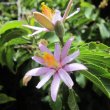
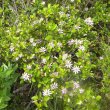
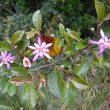
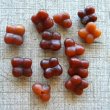
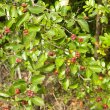
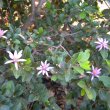
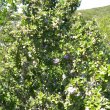

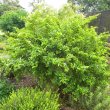



Comments
I see the American gardeners
I see the American gardeners call this lavender star - a more appealing name than our cross-berry
Lavender Star
Hi Diana
Thanks for your comment. I had not come across this attractive name before and have added it to my list of Common Names above. I also added a picture of the fruits from which Grewia gets its common name.
Regards
Lorraine
I purchased the plant without
I purchased the plant without a tag 4 weeks ago, from the gardening store. I didn't know what to call it till yesterday, people just don't grow it in Australia. How sad?? Once the flowers die off I am going to try propagation see how it goes, then give the plant to friends our weather seem to suit the bush mine has lots of flowers just beautiful.many thanks Maggie Canberra Australia.
Propagating Crossberry
Hi Maggie
Great to hear from you 'Down Under'.
Crossberry seeds germinate best when they have been through the gut of monkeys and birds but they will germinate reasonably well from fresh, well-cleaned seed. Once the seeds are a deep reddish brown, separate the seeds and wash off the coating and flesh - you can suck them if you want but I find the coating tough and the flavour of veld fruit a bit "wild" tasting. Plant them about 5 mm deep and keep them slightly moist and sheltered. The seedlings grow quite fast.
Hope you have much success.
Kind regards
Lorraine
Have just planted Grewia
Have just planted Grewia lasiocarpa. Want it to grow to small tree so have pruned it to a leader and a few side branches. What is the difference between this one and the Occidentalis?
Grewia species
Hi Marion
There isn't a vast difference between these two. The flowers, growth form and size are very similar. The differences are as follows:
Grewia occidentalis
Crossberry
Leaves slightly rounded
Leaves hairless or slightly hairy
Fruit smooth, glossy
Flowers October to January
Fruiting January to May
Grewia lasiocarpa
Shaggy raisen
Leaves broad, almost circular
Leaves distinctly hairy, rust coloured
Fruit reddish and furry
Flowers January – March
Fruiting May – June
Kind regards
Lorraine
Grewia - Lavenderstar in Bonsai form
I'm basically now, strictly an out-door gardener. I fell for The Bonsai form of this tree, not knowing a thing about it but brought this little beauty in bloom home anyway. In searching about it I learned that this basically shrub is native to S Africa, Australia & Asia. Desiring to know more, I ran into your site with hopes to see an image of an actual tree. Unfortunately I'm in zone-3 in middle USA known better as the Mid-West, I doubt I can have one outdoors unless in pot & will have to bring in.
Thank you for what I have learned so far, from your Q&A here!!!
Grewia bonsai
Hi Ditas
Welcome to the site.
Yes, zone 3 would definitely be too cold for Grewia. I have never seen this shrub as a bonsai - do you have a photo you could send to my email? In South Africa it tends to grow very leggy and often twines through other bushes and trees. It is not much used in gardens as it needs constant pruning to keep it bushy.
The plant is actually native to Southern Africa. I know that it has become naturalized and somewhat invasive in Australia and Hawaii but I had no idea that it had spread to Asia as well!
I do hope your bonsai brings you much joy.
Kind regards
Lorraine
Grewia occidentalis
Hello, please advise me is this shrub/tree is fast growing.
Thanks Kind regards Wray Bullock
Grewia occidentalis - rate of growth
Hi Wray
Without knowing where you stay it is difficult to give you an answer. Under ideal conditions it is fast growing. Mouse over the question mark next to the heading Growth Rate above for more information as to how certain variables may slow the rate of growth. Let me know in which area you are living if you want a more precise assessment.
Kind regards
Lorraine
Grevia oxidentalis as a Bonsia Plant
I have been given this plant as a Bonsai and placed it in indoors. After a week it appeared that it was not doing well at all. The local nursery was asked for advice who informed me that this plant is an outdoor plant and requires full sun. This I did and consequently the leaves all were burnt and fell off. I am trying to save the plant but need to know, Is it a full sun or shade type plant. Please assist.
Grewia occidentalis Bonsai
Hi Jack
Firstly, the reason the leaves burnt and fell off is a result of the shock from being moved from indoors, directly into the sun, without any hardening process. Any plant would react the same way. It should have been placed in the sun for brief periods each day, the exposure time lengthening until the plant was strong enough to cope with full sun. It's a bit like that first day of holiday at the beach - too much sun too soon.
Secondly, sun or shade. Take a look at the 7th heading above labelled 'Position'. This will answer the question.
Thirdly, your Bonsai. I am really not a bonsai specialist. I googled 'Grewia occidentalis bonsai' and found a number of sites with information on growing this species as a Bonsai, which I am sure you will find helpful.
From the sound of it, it seems your plant is now in severe stress, but Grewia is a fighter and can usually recover from quite a lot of punishment. You may want to contact one of the many Bonsai clubs to get some specialist advice.
Kind regards
Lorraine
grewia occidentalis
Grewia occidentalis is very popular in Auckland New Zealand where it is mostly trained into single stem lollipops. Due to the cold growing conditions it is not a vigorous grower like it is here on the Kwazulu Natal north coast as a result the amount of flowers in proportion to leaves in very much higher than here making it a very attractive shrub. I have also see Grewia occidentals growing as a large container plant in WIlhelmshaven Germany where I lived there they are taken inside during the coldest time of year. Attached is a photo of a very nice natural form that grows at Mount Moreland where I now live. The flowers are tasty and high in protein. They are loved by my african veld goats and nguni sheep.
Discuss this plant
Share knowledge, ask a question or give an experience.